GRE Data Interpretation Practice Questions on Chart, Graph and Table
GRE Data Interpretation: In the GRE, quantitative reasoning questions are asked in two sections, each with three questions. This means there will be a total of six questions combining both sections. In this article, you will find GRE Data Interpretation Practice Papers 2025, GRE Data Interpretation Question Papers 2025, and Data Interpretation GRE Tips and Tricks 2025.
This Story also Contains
- What is Data Interpretation on the GRE?
- Why Practice GRE Data Interpretation Questions?
- Understanding Data Interpretation Questions on the GRE
- Types of GRE Data Interpretation Formats and Questions:
- Strategies for Tackling GRE Data Interpretation Questions
- Practice Papers for Data Interpretation
- Tips for Using GRE Data Interpretation Practice Papers 2025 Effectively
- How to Simulate Test Conditions:
- Reviewing and Analysing Mistakes
- Additional Resources
- Conclusion:
- Final GRE Data Interpretation Tips for Success
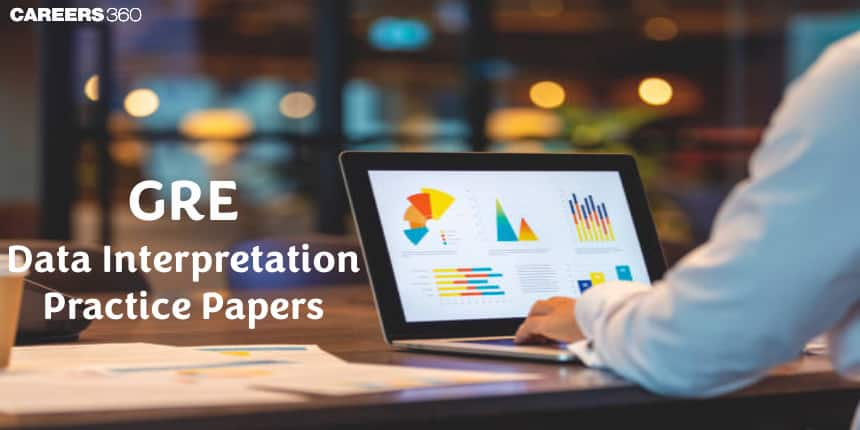
The GRE quantitative section contains three types of questions:
Quantitative Comparison
Problem-Solving
Data Interpretation
What is Data Interpretation on the GRE?
Data Interpretation in the GRE is one of the questions asked in the GRE maths. These questions use different types of graphs to represent the data and you need to analyze and interpret the data to find the answers to the questions followed.
You will get around 6 questions from data interpretation across the sections. These questions are not more challenging than the other types but usually require more time.
Also Read: Data Interpretation Practice Questions
Why Practice GRE Data Interpretation Questions?
GRE Data Interpretation questions assess your ability to understand, visualize, and use the information effectively. These skills are also important for being a data analyst and can be required at any stage of your career. Also, it is a crucial part of the Quant section on the GRE as 3-4 questions are expected in each section of the GRE maths.
Data Interpretation in the GRE doesn’t require an understanding of complex math concepts. You need to focus on some basic concepts like percentages, averages, and basic mathematical concepts. For example, figures/graphs/charts, allow you to understand the information given in the question without making any effort to read a long passage. Graphs help you learn a lot of information in a shorter amount of time, but the chances of error also increase.
If you are looking to achieve a score of 160+ in the Quant section, then it is important to spend enough time to learn and practice Data Interpretation questions.
Download: eBook for Data Interpretation
Understanding Data Interpretation Questions on the GRE
These types of questions on the GRE are meant to analyze data. To understand this effectively and efficiently, you need to know the types of graphs used to represent the data.
Types of GRE Data Interpretation Formats and Questions:
Several types of graphs, tables, or charts represent the data. On the GRE, data interpretation questions are asked in various forms. You need to learn different forms of data representation so that you can familiarize yourself with these.
Let us discuss them one by one.
GRE Data Interpretation Table Questions
In tables, the data is given in an organized form but not represented visually. You should analyze the data to see any trend in the values.
Example:
The following two questions are based on the table below, which is a record of the number of employees in the different departments of an organization.
Department | Number of employees | Average Salary per month (in dollars) | Average Age |
HR | 8 | 1150 | 29 |
Production | 20 | 1350 | 31 |
Services | 32 | 1275 | 24 |
Medical Assistance | 6 | 1375 | 34 |
Training | 8 | 1400 | 26 |
Question: What is the average age of the employees in the HR and Training department together?
(A) 26
(B) 27
(C) 27.5
(D) 28
(E) 29
Solution:
The average age of the employees in the HR and Training department together = (29×8+26×8) / 16 = 27.5 years
Hence, the correct answer is option C.
GRE Data Interpretation Graph Questions
The common graphs asked in the GRE are Bar graphs, line graphs, and Histograms.
Bar Graphs: Data represented in the form of rectangular vertical or horizontal bars where one parameter is given on the x-axis and the other parameter is given on the y-axis is called a bar graph.
The height of the bar is proportional to the value of the parameter.
Example:
The following question is based on the bar graph below, which shows the results of a survey about the favourite colour of children in a school.
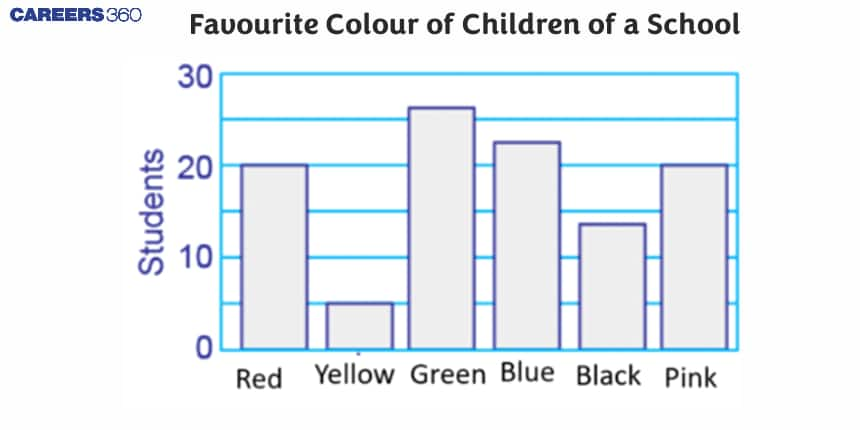
Question: What percentage of the students have black colour as their favourite?
(A) 10.2%
(B) 12.5%
(C) 25%
(D) 27%
(E) 29.3%
Solution:
Estimate the number of students in each bar, then add.
20 + 5 + 26 + 23 + 13 + 20 = 107
Students with black colour favourite = 13
Required percentage = 13 / 107 ×100 = 12.15%
Hence, the correct answer is option B.
Line Graphs: A line graph shows the relationship between points over time by a line or curve. Data is represented at the points of the line graph.
It is best for displaying continuous data or a sequence of values.
Example:
The following question is based on the line graphs below. The graph below shows a company’s earnings for each month between April and August.
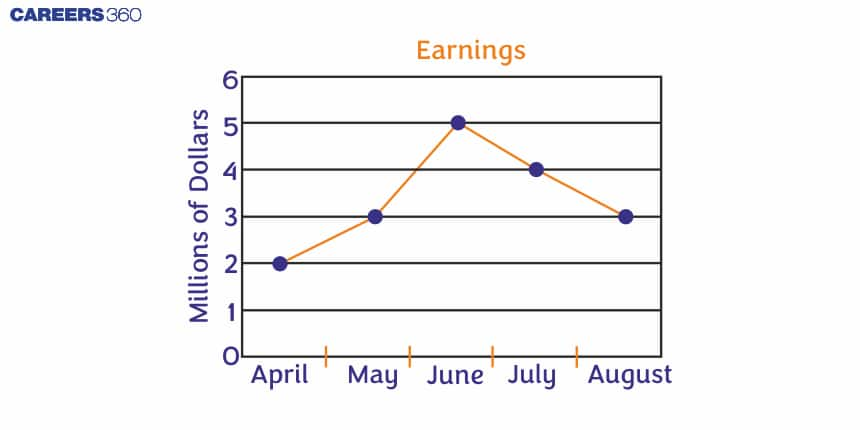
Question: By what percentage have the company’s earnings increased from April to August?
(A) 50%
(B) 65%
(C) 75%
(D) 100%
(E) 150%
Solution:
The company’s earnings in April = 2 million
The company’s earnings in August = 3 million
Percentage increase in the earnings = (3-2) / 2 × 100 = 50%.
Hence, the correct answer is option A.
GRE Data Interpretation Charts Questions
The data interpretation questions asked are mainly based on pie charts. A pie chart is a circular chart divided into sectors; each sector represents the data for an entity.
These charts are divided either in terms of angles or percentages.
Pie Chart Example:
The various expenditures incurred by a renowned publishing company in the US for publishing books in 2023 are given below in a pie chart.
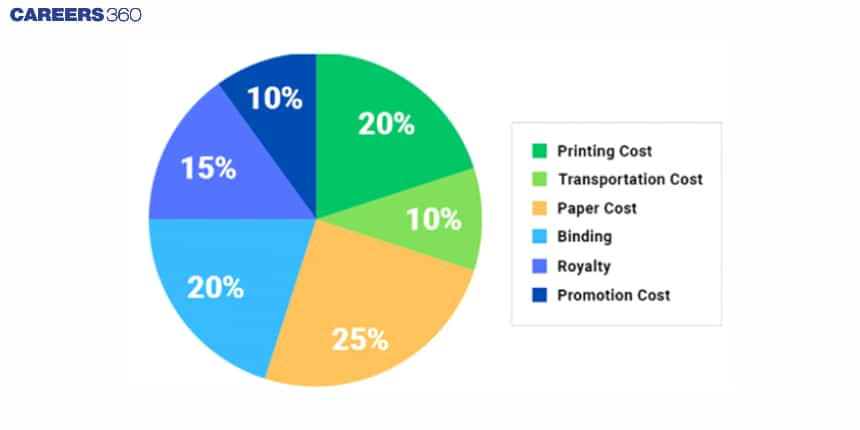
Question: If the expenditure on printing cost is $2000 more than the expenditure on royalty, find the expenditure on paper cost of the company.
(A) 2000
(B)4000
(C) 6000
(D)10000
(E) $12000
Solution:
The company’s expenditure on printing costs = 20%
The company’s expenditure on royalty = 15%
So, 20% - 15% = 2000⇒52000
Now, the Company’s expenditure on paper cost = 25% = 5 × 2000 = 10000
Hence, the correct answer is option D.
Questions on Scatter Plots
A scatter plot is generally used to represent data to examine two variables for a common set of subjects.
For example, a scatter graph can be used to represent the age and religious views of a group of people. Another example could be the relationship between the annual income and the number of kids in a group of people.
Example:
Refer to the following graph to answer the question follows
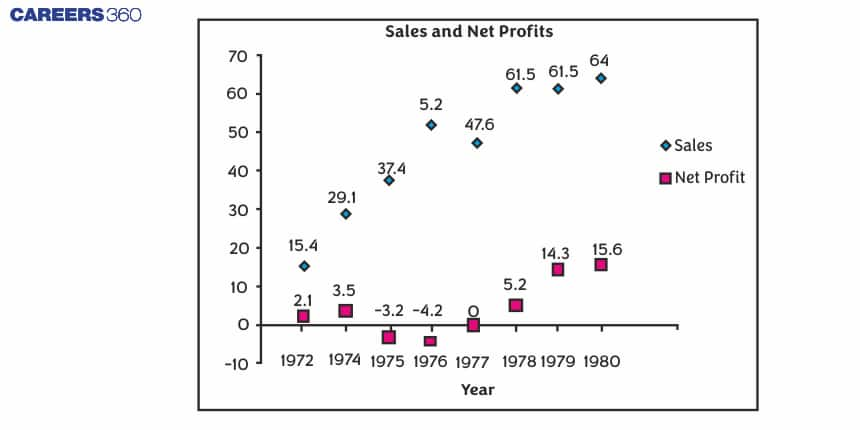
Question: What is the difference between the sales and net profit (in Rs. Lakhs) in 1978?
(A) 19.8
(B) 27.5
(C) 43.5
(D) 56.3
(E) 59.7
Solution:
Sales (in Rs. Lakhs) in 1978 = 61.5
Net Profit (in Rs. Lakhs) in 1978 = 5.2
Difference = 61.5 – 5.2 = 56.3
Hence, the correct answer is option D.
GRE Data Interpretation Passages with Data (Caselet) Questions
Information is given in the form of a paragraph. There is no visual representation of data. You need to read the passage carefully to fetch the key information.
These paragraphs are based on either reasoning or numeric data.
Example:
Directions: Study the given information carefully to answer the following question.
Three friends, Sam, Rads, and George, spend 12%, 14%, and 16% of their monthly salary on travelling in the given order, and each of them saves half of the remaining amount. The monthly salary of Sam and George is the same, and the monthly savings of Sam are 36 more than those of George. The total expenditures of Sam and Rads together on travelling are 124 more than that of George.
Question. What is the monthly income of Sam, Rads, and George altogether?
(A) $1400
(B) $1800
(C) $2200
(D) $3600
(E) $5000
Solution:
Let the monthly income of Sam = the monthly income of George = 100xExpenses of Sam on travelling = 12x
Expenses of George on travelling = 16xSinceeachofthemsaveshalfoftheremainingamount,SavingsofSam=(100x–12x)/2=44xSavingsofGeorge=(100x–16x)/2=42xAccordingtothequestion;44x–42x=36So,x=18So,monthlyincomeofSam=monthlyincomeofGeorge=1800
Also, Expenses of Sam and George on travelling = (12x+16x)=504
Therefore, the Expenses of Sam and Rads on travelling = (12x+16x + 124)
So, 14% of monthly income of Rads = 16x – 12x + 124 = 4x + 124 = (72+124)=196
So, the monthly income of Rads = 1400
The monthly income of the three altogether = (1800+1800+1400)=5000
Hence, the correct answer is option E.
Other graphs can also be used to represent the data, such as:
Double Bar Graph
Spider graph
A combination of two or more charts.
Strategies for Tackling GRE Data Interpretation Questions
The information needed to solve the questions is given in the graphs. You need not take any value on your own. You just need to make proper strategies to solve these questions.
Particularly, you must have
Read and analyse the details given in the question.
Ability to interpret all the necessary information from the graphs and avoid irrelevant information.
Here are some Data Interpretation GRE Tips and Tricks 2025 to ace the data interpretation questions in the GRE.
Tip 1: Analysing the Data Efficiently
When the DI questions pop up in front of you, the first thing you should do is to have a look at the image in the question and understand the data provided in the image.
Few things you need to do:
Read the graph properly.
Interpret the values accurately.
Understand the concept required to solve the associated questions.
If any value is missing, find that value first.
Tip 2: Identifying Key Information Quickly
After analysing the data, the next thing you should do is look for key information. Read the question statement carefully and understand what is asked in the question.
Sometimes, excess information is given in the question, you need to avoid the excess information and identify the appropriate information required to answer the question. The DI section tests your focus and presence of mind. If you don’t read the question properly, then you may end up choosing the wrong answer choice. This is because of a time crunch and being overconfident.
Common things to focus:
Units of measurement on the axes
Decimal points
Correct Units
Tip 3: Common Mistakes to Avoid
There are plenty of mistakes students often make while solving the data interpretation questions.
You should avoid such mistakes, and a few of them are listed here:
The question should be solved only based on the information provided with the question itself. Do not use any information that is not given in the question.
Wasting too much time on a single question.
Generally, due to a time crunch, students often don’t read the question properly. You should not do that.
Do not misinterpret the information. It happens because of impatience or overconfidence.
Sometimes, students get so involved in solving the question that they forget to look for the time, and at last they suffer a lack of time. So, always have an eye on the clock.
Finding this section easy, students avoid practising this section. Do not do that. Practice more to master this section.
Tip 4: Time Management Tips
You need to solve the question within the given time. So, you need to manage the time during the exam.
Here are some suggestions you may follow:
To analyse the graph and identify the key information, you should spend about 30 to 40 seconds.
You need to remember that you have about 2 minutes to solve a question. So, you have to do your calculations in 1 minute.
To save time, don’t use too much formula approach. Think beyond the formulas. Spend only 15 to 30 seconds analysing the graph and jotting down key information. Then, proceed with your calculations. Remember, you only have 2 minutes for each question.
Since these questions usually take more time to solve as compared to other quant questions. You need to balance the time throughout the section.
Practice Papers for Data Interpretation
Here, we are going to solve a few sample questions.
Practice Paper 1
Question Set: 1
Directions for Q1 to Q4:
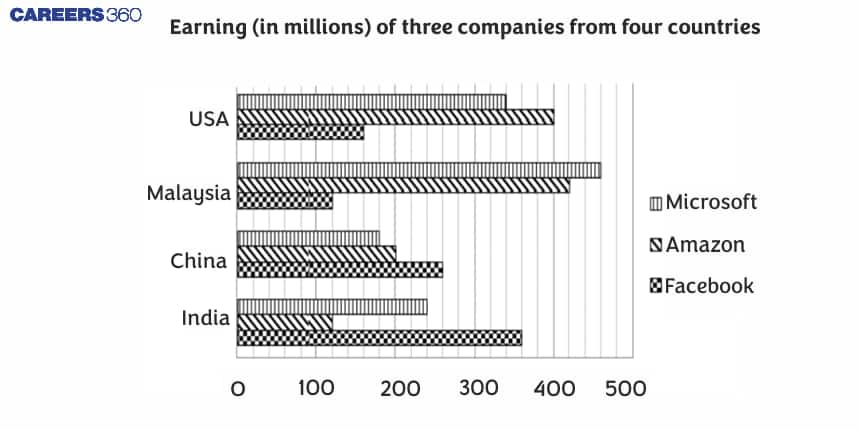
Q1. What is the Average earnings of three companies from China (in millions)?
A. 200
B. 205
C. 213
D. 219
E. 226
Q2. By what percentage of the earnings of Amazon from India is less than that of China?
A. 20
B. 40
C. 80
D. 100
E. 150
Q3. Find the total earnings of Microsoft across the countries (in millions).
A. 460
B. 800
C. 1020
D. 1220
E. 1440
Q4. What is the difference between the total earnings of Amazon from the USA and Malaysia and the total earnings of Facebook from all four countries (in millions)?
A. 0
B. 20
C. 40
D. 60
E. 80
Question Set: 2
Directions for Q5 to Q8:
Answer the questions based on the following information.
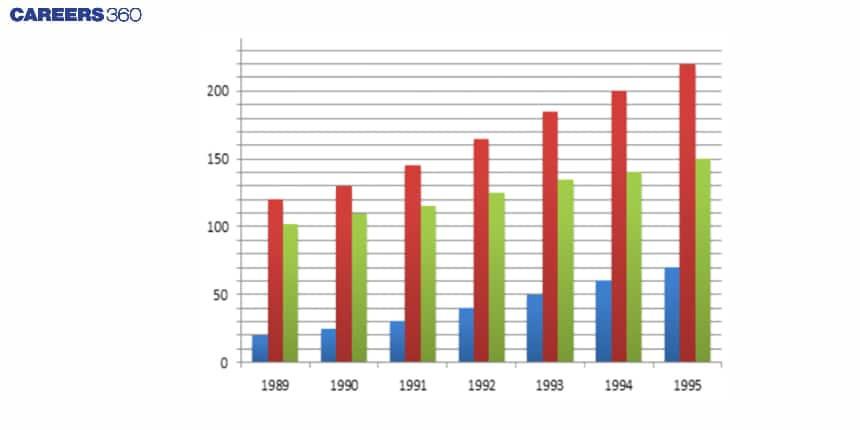
The 1st bar, 2nd bar, and 3rd bar show profit, revenue, and expenditure respectively.
Q5: What is the percentage increase in the revenue from 1989 to 1995?
A. 15.79
B. 28.28
C. 37.45
D. 45.45
E. 54.54
Q6: What is the average expenditure from 1991 to 1994?
A. 105.79
B. 128.75
C. 137.45
D. 145.40
E. 162.24
Q7: The expenditure in 1990 is what per cent of the expenditure in 1995?
A. 27
B. 51
C. 73
D. 81
E. 90
Q8: Profits from 1993 to 1995 are what per cent more than the profits from 1989 to 1991?
A. 153
B. 170
C. 185
D. 203
E. 213
Answers and Explanations:
Answers:
Q1 | C | Q2 | B | Q3 | D | Q4 | E |
Q5 | D | Q6 | B | Q7 | C | Q8 | A |
Explanation:
1. The average earnings of the three companies from China = 180 + 200 + 260 / 3 = 213.33 million.
2. Estimate the value of earnings of Amazon from China and India and then find the required percentage.
Earnings of Amazon from China = 200 million
Earnings of Amazon from India = 120 million
Required percentage = 200-120 / 200 × 100% = 40%.
3. Estimate the earnings of Microsoft across the countries and add them.
Total earnings of Microsoft across the countries (in millions) = 340 + 460 + 180 + 240 = 1220.
4. Estimate the earnings of Amazon from the USA and Malaysia and the total earnings of Facebook from all four countries.
The earnings of Amazon from the USA and Malaysia (in millions) = 400 + 420 = 820.
Total earnings of Facebook from all four countries (in millions) = 160 + 120 + 260 + 360 = 900.
Required difference = 900 – 820 = 80.
5. Estimate the revenue in 1989 and 1995 and then compare them.
Revenue in 1989 = 120
Revenue in 1995 = 220
Percentage increase in the revenue = 100 / 220 × 100 = 45.45%
6. Estimate the expenditure from 1991 to 1994 and then add them to find the average.
Sum of the expenditure from 1991 to 1994 = 115 + 125 + 135 + 140
Average = (115 + 125 + 135 + 140) / 4 = 128.75
7. Estimate the expenditure from 1990 and 1995.
The expenditure in 1990 = 110
The expenditure in 1995 = 150
The required percentage = 110 / 150×100 = 73.33%
8. Estimate the profits from 1989 to 1991.
Estimate the profits from 1993 to 1995.
Profits from 1989 to 1991 = 20 + 25 + 30 = 75
Profits from 1993 to 1995 = 50 + 60 + 70 = 190
The required percentage = 115 / 75×100 = 153.33%
Practice Paper 2
Question Set: 1
Direction (1 to 4): Read the following chart and answer the following Questions:
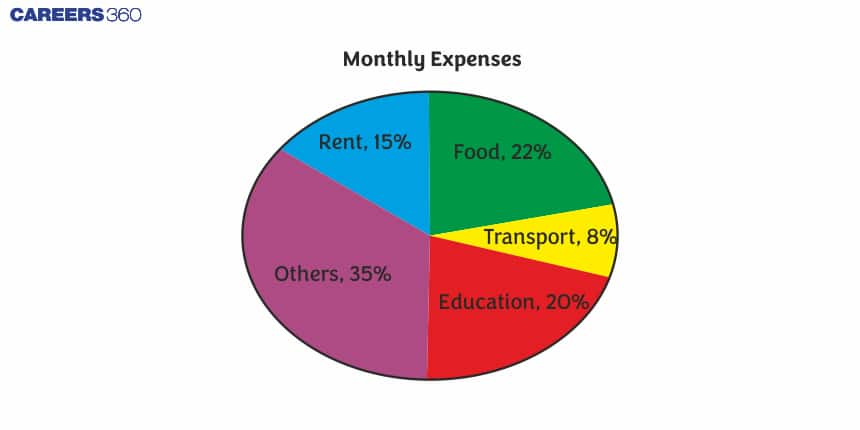
Q1. If John spends $200 on transport, find his expenses on rent and education together is:
A. $375
B. $500
C. $700
D. $875
E. $950
Q2. If Maria spends $220 on food in a month, what is her monthly income?
A. $330
B. $450
C. $550
D. $880
E. $1000
Q3. If the expenses on 50% of the ‘Others’ is $350, then the difference between the expenses on Transport and Food is:
A. $280
B. $350
C. $440
D. $600
E. $680
Q4. Find the angle made by the expenditure on rent, food, and education put together at the centre.
A. 1200
B. 1600
C. 1800
D. 2050
E. 2400
Question Set: 2
Directions (Q5-Q8): The following line chart shows the ratio of exports to the imports of five companies A, B, C, D, and E in the years 2000 to 2004
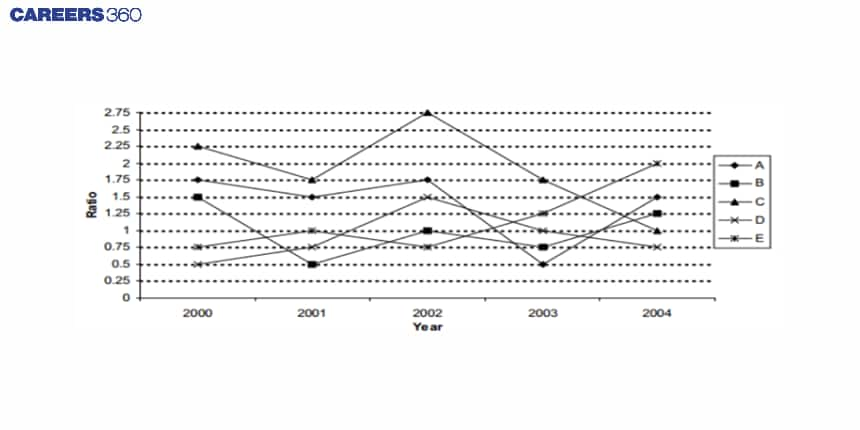
Q5. In 2000, the exports of company A were $30,000 more than its Imports then find the value of imports of company A in 2000.
A. $13000
B. $14500
C. $25500
D. $40000
E. $51000
Q6. If the Imports of Company D and E were the same in 2002, then by what per cent is the export of Company E greater than that of Company D?
A. $33
B. $45
C. $55
D. $88
E. $100
Q7. The Exports of companies A, B, and C in the year 2004 are 33000,24000, and $27000 respectively. What is the sum of imports of companies A, B, and C in the same year?
A. $23000
B. $24800
C. $35500
D. $48800
E. $68200
Q8. If in 2003, the import of company C is equal to the import of company D. By what percentage is the export of company C more than that of D?
A. 34
B. 51
C. 75
D. 81
E. 90
Answers and Explanations:
Answers:
Q1 | D | Q2 | E | Q3 | A | Q4 | D |
Q5 | D | Q6 | A | Q7 | E | Q8 | C |
Explanation:
1. Estimate the expenses using the given information.
8% of expenses = $200
So, expenses on rent and education together = 35% = 2008 × 35 = $875.
2. Estimate the value of 1% of monthly income of Maria.
Maria’s expenses on food = 22% = $220
So, 22% of the monthly income of Maria = $220
So, the monthly income of Maria = $1000
3. Expenses on ‘Others’ = 35% = $700
Difference between the expenses on Transport and Food = 22% - 8% = 14% = 700 / 35 × 14 = $280
4. Here, 100% = 360o
Expenses on rent, food, and education put together = 15% + 22% + 20% = 57%
An angle formed by rent, food, and education put together = 57 / 100×360 = 205.2o
5. Export of company A in 2000: Import of company A in 2000 = 1.75 = 7/4
Assume that Export = 7x and Import = 4x
So, the difference between Imports and Exports = 3x = $30000
So, the value of Import = 4x = 30000 / 3×4=$40000.
6. Export of company D in 2002: Import of company D in 2002 = 0.75 = 3/4
Assume that the Export of Company D = 3 and import of Company D = 4
Now, Export of company E in 2002: Import of company E in 2002 = 1
Assume that the Export of Company E = 4 and the import of Company E = 4 (Since the import of Company D and E are the same)
So, required percentage = 4-33×100=33.33%
7.
Company | Export: Import | Export | Import |
A | 1.5 = 3: 2 | $33000 | $22000 |
B | 1.25 = 5: 4 | $24000 | $19200 |
C | 1: 1 | $27000 | $27000 |
Total Import = 22000+19200+27000=68200
8. For company C, Export to import is 1.75 = 7: 4
For company D, Export to import is 1 1 = 1: 1 = 4: 4
So, required percentage = 7-44×100=75%
Practice Paper 3
Question Set: 1
Directions (Q1-Q4)—Study the following case carefully and answer the questions that follow— Mr. Nicholas Tesla has recently acquired four companies—A, B, C, and D. He noticed that the sales of Company D are half that of Company A, whereas the profits of Company A are double that of Company D. The expenses of Company C are 2millionlessthanthoseofcompanyD.Whereas the profit of company B is 1 million less than that of company C. The expenses of company A are two times those of company D. It is also known that the sales of company C are 12 million, or one-fourth those of company B. An insider further informs Mr. Nicholas that the sales of company D are 10 million more than those of company C, and the expenses of company A are 80% of its sales.
Note—1. All figures are for the years 2005-2006.
2. Profit = Sales – Expenses.
Q1. What is the total sale of all four companies (in million dollars)?
(A) 117
(B) 125
(C) 126
(D) 150
(E) 160
Q2. The expenses of the company A exceed that of the company C by (in million dollars)
(A) 17·6
(B) 19·6
(C) 18·6
(D) 30·8
(E) 50.6
Q3. The Profit of company A is (in million dollars)
(A) 4.4
(B) 6.6
(C) 8·8
(D) 10·8
(E) 11.6
Q4. The expenses of the company B exceed the profit of the company A by (in million dollars)
(A) 43·8
(B) 44·2
(C) 53·8
(D) 62·2
(E) 64.8
Question Set: 2
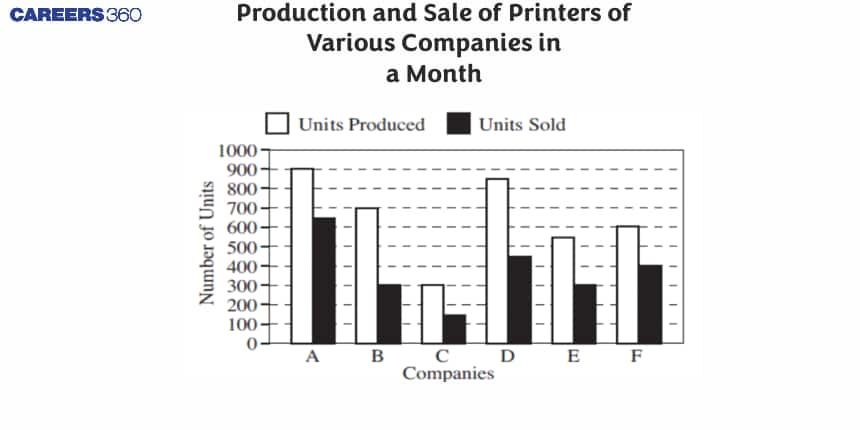
Q5. What is the average number of Units sold by B, D, and F together?
(A) 360
(B) 380
(C) 390
(D) 375
(E) 410
Q6. Production by D is what per cent more than by production by B?
(A) 7.5
(B) 14.28
(C) 18
(D) 21.42
(E) 25
Q7. The average number of Units produced by all the Companies together is less than the Units produced by A alone by ____________
(A) 350
(B) 275
(C) 250
(D) 450
Q8. The total units sold by Companies A, B, and C together is approximately what per cent of the total units produced by these Companies?
(A) 50
(B) 58
(C) 62
(D) 72
(E) 82
Answers and Explanations:
Answers:
Q1 | C | Q2 | B | Q3 | C | Q4 | A |
Q5 | B | Q6 | D | Q7 | C | Q8 | B |
Explanation:
1. From the information given, we can deduce that
Sales
D = A/2
C = $12 million = B/4
So, B = $48 million
D = C + 10million=22 million
A = 2D = $44 million
A + B + C + D = 44 + 48 + 12 + 22 = $126 million
2. Sales of company A = $44 million
Expenses of company A = 80% of 44 million = 35.2 million
Profit of company A = 44 – 35.2 = $8.8 million
Profit of company D = A/2 = $4.4 million
Expenses of D = 22 – 4.4 = $17.6 million
Expenses of C = 17.6 – 2 = $15.6 million
A – C = 35.2 – 15.6 = $19.6 million
3. Sale of company A = $44 million
Expenses of company A = $35.3 million
Profit of company A = 44 – 35.2 = $8.8 million
4. Profit of company A = 44 – 35.2 = $8.8 million
Sale of company B = $48 million
Expenses of C = 17.6 – 2 = $15.6 million
Profit of company C = 12 – 15.6 = - $3.6 million
Profit of company B = -3.6 – 1 = - $4.6 million
Expenses of company B = 48 – (-4.6) = $52.6 million
So, required difference = 52.6 – 8.8 = $43.8 million
5. Average units sold by B, D, and F together = (300 + 440 + 400)/3 = 380
6. Required percentage = 850-700 / 700×100% = 21.42%
7. Average number of Units produced by all companies = (900 + 700 + 300 + 850 + 550 + 600)/6 = 650.
Required difference = 900 – 650 = 250
8. Total units produced = 900 + 700 + 300 + 850 + 550 + 600 = 3900
Total Units Sold = 650 + 300 + 150 + 450 + 300 + 400 = 2250
Required percent = 2250 / 3900×100% = 57.69%
Tips for Using GRE Data Interpretation Practice Papers 2025 Effectively
Using practice sets effectively is an art. You must be the master of that art. There are a few important points to remember while using practice sets such as
Create an exam-like environment at your home
Learn from your mistakes
Give proper time to practice sets and include them in your study plan.
Let us discuss these in detail.
How to Simulate Test Conditions:
You are recommended to create an environment just like the exam environment that you might get on the day of the exam. This can help you to get in the right mindset.
What you should do:
Choose the right space to take your practice sets, where you get proper light, and the place needs to be quiet.
Ensure that there is no distraction or minimal distraction or noise.
Keep a water bottle with you.
Check your internet connectivity before taking the test.
Ensure to finish the exam in a single go.
Also, you can incorporate this into your practice sessions.
Reviewing and Analysing Mistakes
Reviewing and analysing your mistakes will help you to grow up as an individual. It will help you to understand the common errors that you should not make during exams.
There are three steps to follow:
1. Review first: You should acknowledge your mistakes and make an error log to make a record of common errors that you are making.
2. Analyse: Analyse the errors and mistakes. Understand what types of errors you are making, understand why the silly mistakes are happening, and what you need to do to rectify them.
Categorise your errors in:
Conceptual errors
Calculation Errors
Silly Mistakes
3. Learn from the mistakes: The most important part is learning from the mistakes. Update your error log after each test and check the trend of the error. For good preparation, this trend should be decreasing. After each test, the number of mistakes should decrease.
This practice will help you to understand the weaker portion and the general errors that you are making. Practice more in these areas.
Incorporating Practice into Your Study Plan
You are suggested to create a study plan in which you should incorporate the practice tests at a regular interval. Also, you should allocate some time to review and analyse your tests and test scores. A good study plan is flexible and can be changed as per requirement.
Additional Resources
You can find GRE prep books offline in hard form available in the market. Also, you can utilise the online portals to take practice tests and practice online. The benefit of online resources is that you can use them anywhere. Here, we are going to suggest some additional useful resources to prepare the data interpretation section.
Recommended GRE Data Interpretation Books
A few books are not GRE-specific, but they will help you prepare for data interpretation.
Logical Reasoning and Data Interpretation for the CAT Book by Nishit K. Sinha
Data Interpretation for CAT by Arun Sharma
To understand the pattern of questions on data interpretation for the GRE, you can read:
The Official Guide to the GRE General Test
Book by Educational Testing Service
Online Data Interpretation Practice Tools
There are plenty of test portals or websites to practice data interpretation, but you should choose the portal that you can trust. To take practice tests from any online portal, you need to check its
Authenticity
Credibility
Market Value
Students feedbacks
Study Material:
GRE Prep Courses and Tutoring
Depending upon your preparation, you are advised to hire a professional tutor to learn all the basics and master this section. If you are very confident in preparing by yourself, then you can get help from free YouTube sessions on data interpretation.
Conclusion:
Preparing for data interpretation requires good visualisation and data interpretation skills. Also, you need to master your basic topics and mental maths to speed up your practice and solve the questions in time during the exam.
Recap of Key Points
In this article, we have discussed
The types of data interpretation questions related to the GRE.
The importance of data interpretation in the GRE.
Practice tests on data interpretation for the GRE.
Learn how to utilise the practice tests.
Study material you should use.
How to incorporate the practice tests in your study plan.
You are recommended to follow the Data Interpretation GRE Tips and Tricks 2025 discussed in this article to prepare for data interpretation.
Must Read:
Final GRE Data Interpretation Tips for Success
Here are some expert Data Interpretation GRE tips and tricks to achieve success in data interpretation:
Tip 1: Read and analyse the graphs carefully.
Tip 2: All information is important.
Tip 3: Do not use any information not given in the question.
Tip 4: Master topics like numbers, percentages, averages, and ratios.
Tip 5: Use an approximation to estimate the answer.
Tip 6: Avoid Silly mistakes.
Tip 7: Practice, Practice, and Practice.
About the Author:
Pooja Aggarwal is an experienced trainer with over 15 years of expertise in helping students achieve their educational goals. With a degree in Education, she focuses on clear, patient, and personalised instruction. Her approach has successfully guided students from diverse backgrounds, preparing them for both Academic and General Training modules of various exams in a supportive and engaging environment.
Frequently Asked Questions (FAQs)
Five or six wrong answers can earn you a near-perfect score on the verbal portion. Therefore, you can only answer two questions incorrectly to receive a perfect quant score; yet, you can answer three questions incorrectly and still receive a perfect verbal score.
The GRE's Data Interpretation or Data Analysis questions, which are a subset of Quantitative Reasoning, are one example. This is an important part of the GRE, and you should anticipate at least six questions related to quantitative reasoning.
Data interpretation is a process of analyzing a given data set, gaining meaningful insight, and understandingably presenting the results using graphs, charts, or tables. The main aim of data interpretation is to understand what is in the data and predict or arrive at relevant conclusions.
There are two types of data interpretation.
Qualitative method: In this method, we analyze categorical data.
Quantitive method: In this method, we analyze numerical data.
Data analysis involves collecting, processing, and summarizing data to extract useful information, while data interpretation focuses on understanding and making sense of the analyzed data to draw conclusions and make decisions.
To interpret a bar graph, examine the labels on the x-axis and y-axis to understand what each axis represents, look at the height or length of the bars to determine the values, and compare the bars to identify patterns, trends, and differences among the data categories.
In GRE quant, you will get 6-7 questions, each carrying a handsome weightage. So, you can not risk avoiding data interpretation questions.
Popular Courses and Specializations
Questions related to GRE
On Question asked by student community
Hello,
It depends on the university you are applying to. Most German universities do not require GATE for admission to a Master's in Biotechnology. However, some universities may ask for the GRE , especially if you are applying to a highly competitive program.
You should check the specific admission requirements
GRE, TOEFL, IELTS, and GMAT are standardized tests often required for admission to universities abroad, but they serve different purposes. The **GRE** (Graduate Record Examination) is used for admission to graduate programs and some business schools, focusing on verbal reasoning, quantitative reasoning, and analytical writing. The **TOEFL** (Test of English
Hello aspirant,
Those who wish to pursue postsecondary education, specifically a Master's degree, specialised Master's programme, MBA, or PhD, are eligible to take the GRE. You must show up for the GRE general exam. Use the following link to get the comprehensive exam details:
https://studyabroad.careers360.com/exams/gre
Thank you
Hope this information
Brooklyn Review is the Best GRE Coaching Center in Hyderabad . There are a variety of factors that makes Brooklyn Review the top rated GRE coaching centre in Hyderabad. Let us a have a sneak peek into the factors that makes Brooklyn Review The Top GRE coaching center in Hyderabad.
Yes, pursuing an M.Tech in Computer Science and Engineering (CSE) through the GRE is possible. Many universities, especially in the US, accept GRE scores for admission into their master's programs in CSE. Strong GRE scores, along with a solid academic record, relevant work experience, and a compelling statement of purpose,
Applications for Admissions are open.
Want to study in Ireland? Explore Universities & Courses
Study in Canada
ApplyExplore Universities, Courses & Subjects | Work while study
Study in UK
ApplyApply for upcoming intake & plan your journey
Study in USA
ApplyUniversities inviting applications | Get expert guidance
Study in Australia
ApplyShortlist best ranked universities & get expert guidance